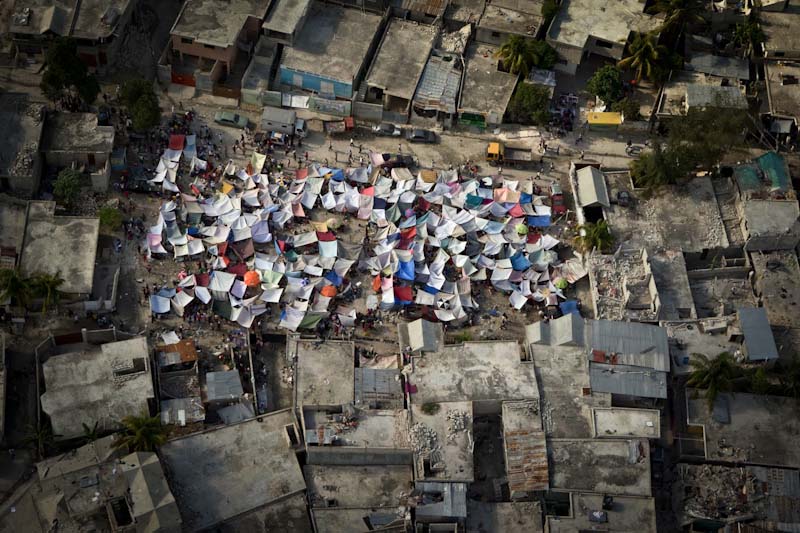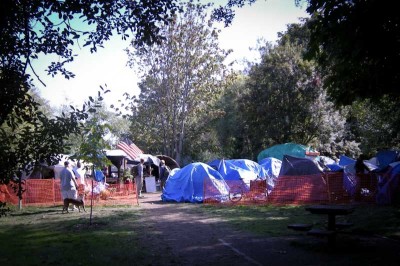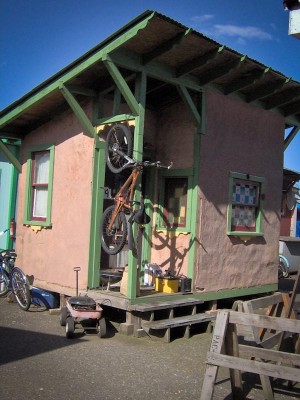 Urban slums may seem like a distant problem only facing poor countries. But Seattle has a history of informal settlements all its own.
Urban slums may seem like a distant problem only facing poor countries. But Seattle has a history of informal settlements all its own.
Tent cities have existed as emergency shelter for thousands of years, often amassing in the wake of natural disasters, political purges, wars and other human catastrophes. For example, the Great Depression caused unprecedented unemployment rates worldwide and forced many American families to live in shanty towns—known as “Hoovervilles”—some of which still exist today as tent cities.
Around the world close to one billion people live in informal settlements or “slums.” By some estimates that population is expected to double by 2030. Residents of slums live in extreme poverty despite being located in industrialized urban centers such as Rio de Janeiro, Istanbul, and Cape Town. Characterized by squalor, overcrowding, high crime rates, and a lack of basic human needs, slums are a more visible and permanent relative of the tent cities we have right here in the Northwest.
The tent in all its forms is a symbol of human adaptability and self-reliance. Millions of nomads, anarchists, and survivalists have chosen to live on the fringes of mainstream society for as long as society has proliferated and forgotten them. Their encampments are small and practical, often camouflaged in wooded areas. Outsiders rarely find them.
Recently, other tent communities have emerged in plain sight in New York, London, and Cairo as part of the Occupy the World movement, protesting social and economic inequality. Given a rare, short-lived public voice, many homeless individuals and families joined the ranks of the protesters. These impromptu and illegal tent cities were ceaselessly raided and ransacked by local police, but what happened to the homeless people when the protest was over?
Those with tents just continued living in them; those without returned to the streets.

Seattle—with its historic homeless population—is the true “home” of the tent city in America. In 1990, Seattle hosted one of the first tent cities created by a sponsoring organization called SHARE. In 2002 Seattle became the first major US city to accept the basic operating principles for a tent city. Ever since, there have been two tent cities operating under city and local ordinances—and one operating unsanctioned—each relocating every three months within a rotation of churches, which are permitted by law to host tent camps.
These tent cities have actually paved the way for other, bigger tent cities across America and overseas.
The Great Recession that began in 2007 is provoking a sharp rise in newly-homeless and unhoused people around the world. As supportive public services in many cities have become overburdened, more people have abandoned the shelter system altogether and move to tent cities.
So are tent cities a housing solution for an ignored community in a crippled economy?

(Photo by Myriam Darmoni)
When surveyed, most people living in tent cities reported they would rather live on the streets than live in the shelter system. Of those who said they would not go to the shelter system, a majority said they would if they were put on a two to three month waiting list for permanent housing.
“Tent cities are Americans’ de facto waiting room for affordable and accessible housing,” said Neil Donovan, executive director for the National Coalition for the Homeless, in a 2010 report. All developed nations have supportive public housing with varying levels of volume and efficacy, but many housing options take months or years to get into.
The perplexing problem in America is that homelessness is on the rise, but eleven percent of houses in our country are empty.
Homelessness is one effect of a complex, systemic problem which most civilizations have never solved. Despite the scarceness of employment—and the unfair stigma surrounding homeless people—many tent city residents work day jobs. In fact, some tent cities are based around employment opportunities: Little Tijuana is a predominantly-Hispanic tent city in Fresno, California comprised of many migrant workers that either don’t want to take the risk of signing a lease or still can’t afford housing.
If permanent housing for all people experiencing homelessness becomes unrealistic, the model of transitional housing in organized tent cities could prevent both temporary and absolute homelessness. Most federal governments believe funds would be more “strategically spent” on long-term housing, but homelessness is an erratic, localized phenomenon.
Tent cities are a pragmatic way to widen the safety net for any community with people at immediate risk of losing their home; though they are not a long-term solution, they may prove to be sustainable.
Dignity Village in Portland, Oregon is a self-governed, self-funded community founded by homeless people (all of whom have since moved on, either to permanent housing or elsewhere). In its 13-year lifespan it has evolved from a traditional tent city into an “eco-village,” along with help from local non-profit organizations and community donations.

(Photo by David Hull)
Dignity Village considers itself a part of the Green Movement: the “houses” are made from recycled materials; amenities include an organic farm, a compost toilet, 24-hour security, and waste removal and recycling provided by the city. The goal is simple: create a safe, sanitary place to live autonomously.
This perspective is not always shared among homeless people. Many are so used to living with absolutely nothing that they can’t envision themselves differently: one third of the people who move to Dignity Village decide to remain homeless in other places; another third are thrown out due to inability to follow the basic rules—including no drugs or alcohol on-site. Addiction—another socioeconomic plague related to poverty—is a major downfall in less organized tent cities.
Still, the initial community concerns—declining property values, safety, fears of vandalism—are often challenged by the reality of tent cities. It is unclear whether or not tent cities make an area “more dangerous,” but police in Seattle, who were also concerned of increased incidents, are now proponents of the encampment, believing that it makes their jobs easier.
Churches often look forward to being the host of the next tent city. Their presence becomes something of an event, an important reminder, and a chance to help people who need it most.
“We have people in this city sleeping outside,” Deputy Mayor of Seattle, Darryl Smith told The Seattle Times last year. “That’s reality. Let’s create as many options as we can.”
Though tent cities will not work everywhere, they are a viable option for a certain strand of homeless people who—despite giving up on their government to provide for them—still believe in themselves enough to pitch a tent in the woods, to figure out how to survive another day.
Today, the tent is a political anti-statement, a temporary escape from the sprawl of modern life, and a valuable lifeline for those edged out of a home against their will.
This post was produced in partnership with AllTreatment.com.
Click here for more stories from Slum Rising, our ongoing series exploring the economically complex and culturally rich life in the world’s urban slums.



America is going to hell get out as soon as you can I would suggest Southeast Asia economics growing there unemployment is 2%
Here is one law standing in the way of safe, permanent housing for low income people. It is called the Faircloth limit, and it stops low income housing at 1999 limits. If we can repeal this thing, we get more low income housing. Please sign the petition
Here is the petition.
http://petitions.moveon.org/sign/repeal-the-faircloth